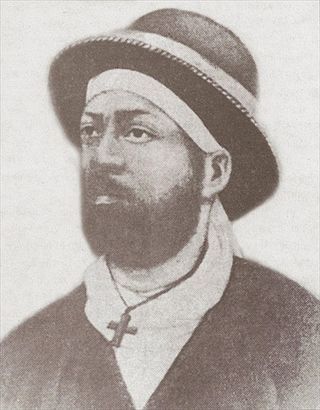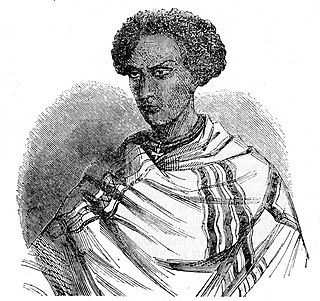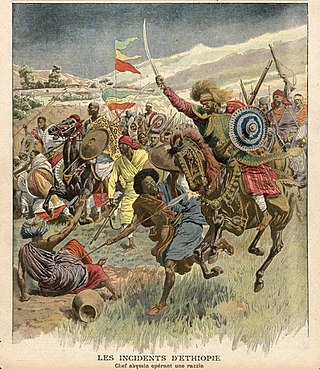


Major Sir William Cornwallis Harris (baptised 2 April 1807 – died 9 October 1848) was an English military engineer, artist and hunter. [1]



Major Sir William Cornwallis Harris (baptised 2 April 1807 – died 9 October 1848) was an English military engineer, artist and hunter. [1]
The son of James Harris of Wittersham, Kent, he entered Addiscombe Military Seminary at the age of fourteen. Two years later, in December 1823, he joined the army of the East India Company as second lieutenant in Engineers, Bombay Establishment. Over the following thirteen years, he was posted to several places in India and was able to pursue his taste for field sports and the depiction of wildlife. He was promoted to first lieutenant in 1824 and to captain ten years later.
In June 1836, Harris arrived at Cape Town on the 1,467-ton Buckinghamshire and stayed for two years in order to recover from a fever. He was fortunate to meet Dr. Andrew Smith, freshly returned from a journey north on which he had visited Mzilikazi at Mosega. From the Cape, he arranged a hunting trip, which was to last from 1836 to 1837, to the Western Transvaal and Magaliesberg with William Richardson of the Bombay Civil Service, who had been a fellow passenger on the voyage.
They sailed to Algoa Bay and made their way to Grahamstown, where they outfitted their expedition and received helpful advice from the ivory traders David Hume and Robert Schoon. Their route took them across the Orange River to Kuruman, where they met Robert Moffat, who had befriended Mzilikazi and was able to provide Harris with useful information about the ruler. Mzilikazi received Harris' presents with pleasure and the expedition set off confidently for the Magaliesberg toward the south-east.
Here they experienced at first hand the struggles of the Voortrekkers against the Matabele. Harris came across his first sable antelope (Hippotragus niger) in the Magaliesberg, and sent a description and specimen of the animal to the Zoological Society of London. David Hume had years earlier decided that it was possible to cross the Kalahari and reach Lake Ngami. Harris was of like mind and made known his willingness to go, but the geographical societies of Bombay and London ignored him.
Harris was one of the more notable of the early Victorian travellers, and his illustrations of the large African fauna were the first to have any claim to accuracy. He hunted on a ruthless scale, even as he wrote with passion about the regions he crossed, and painted the animals he encountered with great attention to detail. He was not an outstanding artist, but his paintings and sketches have great charm and spirit and have considerably enriched natural history art.
He remained at Cape Town to the end of 1837, then for the next three years he resumed his work in Western India as field engineer to the Sindh Force.
From 1841 to 1843, Harris led a British diplomatic mission from Bombay to Sahle Selassie, Negus of Shewa, at the time an autonomous district of Ethiopia, with whom they negotiated a commercial treaty. They also collected extensive scientific data during the trip.
Harris managed to capture the political atmosphere and attitudes of Sahle's court towards his enemies, in a song of praise played by one of his female chorist (Azmari).
In stature like the lance he bears,
His godlike mien the prince declares;
And famed for virtue through the land,
All bow to Saloo's just command.
The sabre feels the royal grasp,
And Pagans writhe in death's cold clasp;
The Galla taste the captive fare,
And dread the vengeance which they dare.— A memorable observation by Major William Cornwallis Harris, of an female Azmari praise of king Sahle Selassie court, in"Misgana (translated from Amharic) praise song", [2]
Harris was gazetted major in 1843 and was knighted in England the following year for his services. After being knighted, Harris acted as executive engineer at Dharwar Dion and Poona. He died near Poona as a result of fever, aged 41.
Harris married Margaret Sligo, daughter of George Sligo of Auldhame in Scotland and niece of General Sir James Outram. Their marriage was childless.

Sir Andrew Smith was a British surgeon, explorer, ethnologist and zoologist. He is considered the father of zoology in South Africa having described many species across a wide range of groups in his major work, Illustrations of the Zoology of South Africa.

Shewa, formerly romanized as Shua, Shoa, Showa, Shuwa, is a historical region of Ethiopia which was formerly an autonomous kingdom within the Ethiopian Empire. The modern Ethiopian capital Addis Ababa is located at its center.

MzilikaziMoselekatse, Khumalo was a Southern African king who founded the Ndebele Kingdom now called Matebeleland which is now part of Zimbabwe. His name means "the great river of blood". He was born the son of Mashobane kaMangethe near Mkuze, Zululand, and died at Ingama, Matabeleland. Many consider him to be the greatest Southern African military leader after the Zulu king, Shaka. In his autobiography, David Livingstone referred to Mzilikazi as the second most impressive leader he encountered on the African continent.
Ankober, formerly known as Ankobar, is a town in central Ethiopia. Located in the North Shewa Zone of the Amhara Region, it's perched on the eastern escarpment of the Ethiopian Highlands at an elevation of about 2,465 meters (8,100 ft). It is 40 kilometers (25 mi) to the east of Debre Birhan and about 90 miles (140 km) northeast of Addis Ababa.

Johann Ludwig Krapf was a German missionary in East Africa, as well as an explorer, linguist, and traveler. Krapf played an important role in exploring East Africa with Johannes Rebmann. They were the first Europeans to see Mount Kenya with the help of Akamba who dwelled at its slopes and Kilimanjaro. Ludwig Krapf visited Ukambani, the homeland of the Kamba people, in 1849 and again in 1850. He successfully translated the New Testament to the Kamba language. Krapf also played a key role in exploring the East African coastline, especially in Mombasa.

Hailemelekot Sahle Selassie was Negus of Shewa, a historical region of Ethiopia, from 12 October 1847 until his death. He was the oldest son of Negus Sahle Selassie an important Amhara noblemen and his wife Woizero Bezabish Wolde.

Debre Birhan is a city in central Ethiopia. Located in the Semien Shewa Zone of Amhara Region, about 120 kilometers north east of Addis Ababa on Ethiopian highway 2, the town has an elevation of 2,840 meters, which makes it the highest town in Africa. It was an early capital of Ethiopia and afterwards, with Ankober and Angolalla, was one of the capitals of the kingdom of Shewa. Today, it is the administrative center of the North Shewa Zone of the Amhara Region.
Wossen Seged was a Merid Azmach of Shewa, an Amhara noble of Ethiopia. He was the elder son of Asfa Wossen, by a woman of the Solomonic dynasty. He was the first ruler of Shewa to claim a higher title than Merid Azmach, calling himself Ras.

Sahle Selassie was the King of Shewa from 1813 to 1847. An important Amhara noble of Ethiopia, he was a younger son of Wossen Seged. Sahle Selassie was the father of numerous sons, among them Haile Melekot, Haile Mikael, Seyfe Sahle Selassie, Amarkegne and Darge Sahle Selassie; his daughters included Tenagnework, Ayahilush, Wossenyelesh, Birkinesh, and Tinfelesh. He was the great-grandfather of Haile Selassie, the last Emperor of Ethiopia

Darge Sahle Selassie, also known by his horse name Abba Gersa, was a 19th-century Ethiopian nobleman, provincial governor, general, and a trusted councillor to his nephew, Emperor Menelik II.

The Sultanate of Aussa was a kingdom that existed in the Afar Region in eastern Ethiopia from the 18th to the 20th century. It was considered to be the leading monarchy of the Afar people, to whom the other Afar rulers nominally acknowledged primacy.

An Azmari is an entertainer who sings and plays traditional string instruments of the Ethiopian Highlands. They are comparable to medieval European minstrels, bards or West African griots.

Johann Martin Bernatz, was a German landscape artist. Born in Speyer and trained in Vienna, Austria, he spent much of his life in Munich. He accompanied an expedition to Egypt and the Holy Land in 1836, and a British embassy to Ethiopia in 1842; drawings made during both journeys were published as sets of lithographs.
The Abbichu Oromo were a subclan of the Tulama Tulama who lived in the Shewa province of Ethiopia. In 1841 William Cornwallis Harris mentioned them as allies of King Sahle Silassie of Shewa.
The Battle of Azule was fought on 6 September 1886, between the forces of Ras Darge Sahle Selassie of Shewa and a force of Arsi Oromo. It was part of a broader series of expansion campaigns done under Menelik II, Negus of Shewa, referred to by some historians as the Agar Maqnat. The battle of Azule was important as it represents the crushing of a large Arsi army by one under Menelik; it also demonstrates the dynamic of gun-wielding Shewans fighting Spear-wielding Arsi that many historians like to stress when discussing Menelik's expansions; it also retains symbolic and historic importance in the politics and identities of many.
Bulga is a former historical region of Ethiopia in the central part of Shewa. It was bounded by the Germama river to the south, which formed the historical boundary between it and Minjar in the south. It presently encompasses the modern woredas of Hagere Mariamna Kesem, Asagirt, and Berehet.
Sharmarke Ali Saleh was a leading 19th century Somaliland leader, captain, and merchant. He was known as "The African Rothschild " which indicates he was one of the richest men living on the African continent at that time and also the 'Political Boss of the Somaliland coast', a title which is a testament to his political influence in the region. He was the governor and ruler of Zeila and Berbera between 1841 and 1861, and for a time was known as the richest man along the Somaliland coast. His descendants would go on to become the traditional leaders of the Musa Arreh sub-clan of the Habr Yunis clan.

Menelik II's conquests, also known as the Agar Maqnat, were a series of expansionist wars and conquests carried out by Emperor Menelik II of Shewa to expand the Ethiopian Empire.
Bashah Aboye horse name: Abba Däffar, was a distinguished Ethiopian military commander under Emperor Menelik II, and governor of several former principalities and regions in the south. Bashah died fighting the Italians during the Battle of Adwa.
Garmame and Horse name: Abba Mala was an influential 19th century Ethiopian military commander, provincial governor and royal counsellor serving under Negus Sahle Selassie, Haile Melekot and Emperor Menelik II. He held the title of Dejazmach. Garmame is remembered for his leading role in rescuing Menelik II and other notables from captivity in July 1865, and restoring the Shewan heir back to the throne. In May 1877 he prevented a coup concocted by Bafena, and solidified the position of his Negus. After retirement from military activities, Garmame governed large tracts of fertile land south of Ankober, and is also remembered for his role in providing relief to the people during the disastrous 1890's famine'.